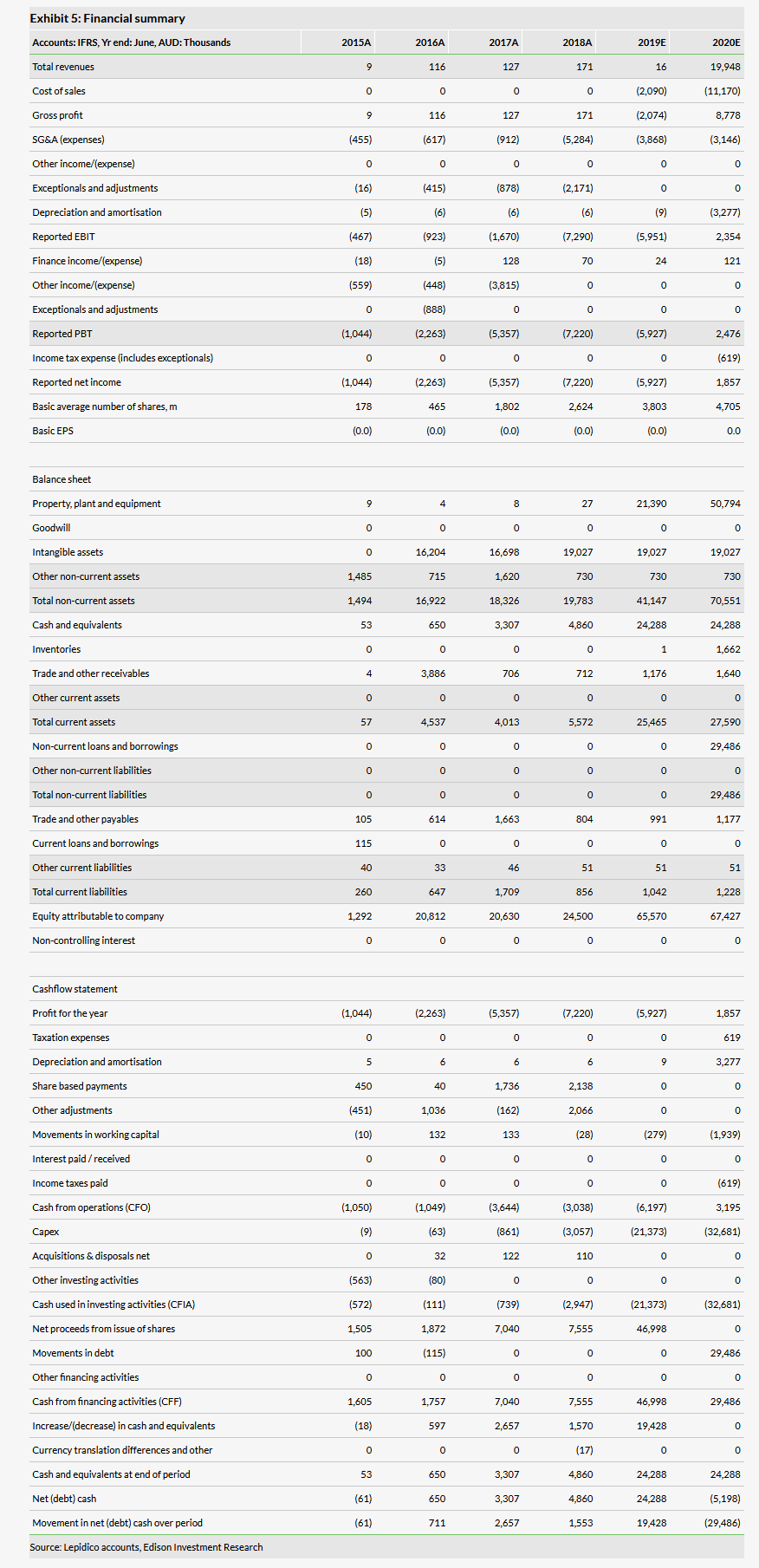On 18 February, Lepidico Ltd (AX:LPD) announced that it had entered into a worldwide exclusivity arrangement over a new proprietary process (LOH-Max™) to produce lithium hydroxide from lithium sulphate. The technology uses established equipment and is expected to incur lower capital and operating costs than the conventional alternative. It seeks to capitalise on the growing preference among battery manufacturers for lithium hydroxide over lithium carbonate as a feedstock, which has resulted in the former now commanding a price premium over the latter. It also dispenses with the requirement for a sodium sulphate circuit in the plant, thereby further reducing capital costs as well as the commercial risks associated with producing this product.

LOH-Max being incorporated into future planning
As a result of this arrangement, LOH-Max™ (hereafter LOH-Max) is being integrated into LPD’s pilot plant, which nevertheless remains on budget and on schedule for commissioning in April prior to one month’s operation in May incorporating LOH-Max. In the meantime, Strategic Metallurgy is developing the process design criteria for consultants Lycopodium to finalise the design for the LOH-Max circuit to be integrated into the Phase 1 plant project full feasibility study, which is expected to be completed next quarter.
Potential capex savings quantified; opex to come
Cost comparisons conducted to date indicate that LOH-Max offers material reductions in both capex (estimated at more than US$10m for a 5,000tpa lithium hydroxide operation) and opex relative to conventional methods of converting lithium sulphate into either lithium hydroxide or lithium carbonate. In addition, on account of their different molar masses, 5,000t of lithium carbonate equates to 5,679t of lithium hydroxide monohydrate in terms of the amount of contained lithium metal.
Valuation: 6.84c/share potentially rising to 7.27c
On the basis of our updated assumptions, we estimate that execution of the 7t/hour Phase 1 plant will result in free cash flow to Lepidico of A$71.2m per year once steady-state production has been achieved. Assuming US$30m (A$41.8m) of equity financing at the prevailing share price, this implies a valuation for Lepidico of A$0.0684/share in FY19 (vs A$0.0398 for the pre-LOH-Max plant), rising to A$0.0910 in FY22 with a A$5.2m net debt funding requirement, or A$0.0727/share (in FY19) with an unchanged A$16.8m net debt funding requirement (implying US$21.2m in equity funding in H219; see page 4). Note that neither of these valuations ascribe value to the Phase 2 plant or other development options.
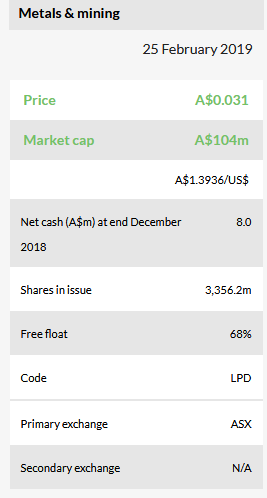
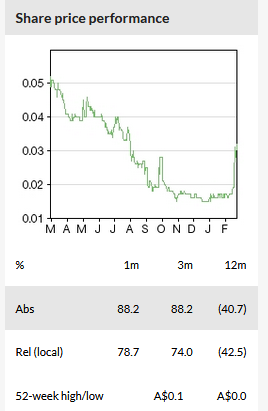
Business description
Lepidico provides exposure to a portfolio of lithium assets via its wholly owned properties, JVs and IP in Australia, Canada and Europe. Uniquely, it has successfully produced lithium carbonate from non-traditional hard rock lithium-bearing minerals using its registered L-Max process technology.
Agreement
On 18 February, Lepidico announced that it had entered into a worldwide exclusivity arrangement over a new proprietary process to produce lithium hydroxide from lithium sulphate. The process was developed in collaboration with the owners of Strategic Metallurgy (a material shareholder in Lepidico) and the agreement grants Lepidico the right to use the process and the sole rights for marketing the technology to third parties worldwide in exchange for Lepidico funding the development of the process.
Rationale
The technology seeks to capitalise on the growing preference among battery manufacturers, in particular, for lithium hydroxide, rather than lithium carbonate, as a process feedstock, which has resulted in the former commanding a premium price compared to the latter. The technology uses conventional equipment and is expected to incur lower capital and operating costs than the erstwhile conventional process to convert lithium sulphate into either lithium hydroxide or lithium carbonate. It also dispenses with the requirement for a sodium sulphate circuit in the plant, thereby further reducing capital costs as well as obviating the commercial risks associated with the production of this material (eg low/negative/commoditised margins and potential additional environmental costs).
Impact
Lepidico’s intention is that L-Max will provide feed to LOH-Max in order to produce either lithium hydroxide or lithium carbonate, depending upon market conditions. In anticipation of this, LOH-Max is currently being integrated into LPD’s pilot plant development, which nevertheless remains on budget and on schedule for commissioning in April prior to one month’s operation in May (incorporating LOH-Max) in order to confirm the design performance of the major component parts of the plant in continuous process at an intermediate throughput rate of 15kg/hour and thereby to minimise subsequent scale-up risk to the Phase 1 plant.
At the same time, in reviewing the engineering for the Phase 1 L-Max plant project, Lepidico has determined that a proportion of re-work will be required to integrate the LOH-Max process. To this end, Strategic Metallurgy is developing the process design criteria for consultants Lycopodium to finalise the design for the new circuit to be integrated into the Phase 1 plant project full feasibility study (which is therefore now expected to be completed during Q2 CY19, around the time of the pilot plant run in order to accommodate LOH-Max).
Valuation considerations
Lepidico has already conducted cost comparisons between LOH-Max and the conventional process to convert lithium sulphate to lithium hydroxide and has concluded that “material reductions in both capital cost – estimated at more than US$10 million for 5,000tpa of lithium hydroxide – and operating cost should be achieved using LOH-Max.” At the same time, lithium hydroxide commands a premium price compared to that of lithium carbonate that has ranged between 53.2% in April 2015 and 9.5% in June 2018:

Although the premium of the lithium hydroxide (monohydrate) price over that of lithium carbonate has therefore narrowed materially over the course of the past two years, it has nevertheless still averaged 16.8% since May 2017. In addition, on account of their different molar masses, 5,000t of lithium carbonate equates to 5,679t of lithium hydroxide monohydrate in terms of the amount of contained lithium metal (ie a factor of 113.6%).
On the basis of the above assumptions regarding output (+13.6% LiOH vs lithium carbonate, ie configured to produce 100% lithium hydroxide monohydrate) and prices (16.8% LiOH premium) plus those set out in our note Lepidico: Piloting its way through, published on 9 October 2018, our estimate of Lepidico’s annual income statement once steady-state production at an (unchanged) output rate of 5,000tpa has been achieved at the Phase 1 L-Max plant (incorporating LOH-Max) is as follows:
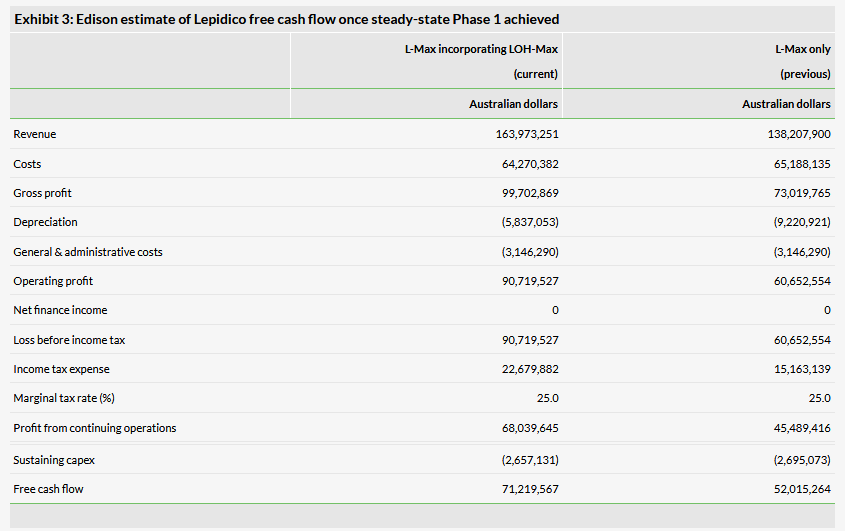
Discounted at a rate of 10% per year over 10 years, steady-state free cash flow of A$71.2m pa (cf A$52.0m previously) has a net present value of A$437.6m (A$319.6.4m previously). This reduces to A$298.9m (A$218.3m previously) to account for steady state not being achieved until FY23 and A$225.6m (previously A$173.3m) once initial capital expenditure had been taken into account.
Ultimately, however, our detailed valuation is derived from the discounting of future, real, maximum potential dividends to shareholders and thus depends, in part, on the degree and price of any future equity financing of Phase 1 capex. In our base case, we have consistently assumed US$30m (A$41.8m at our updated forex rate of A$1.3936/US$) of equity financing in FY19, in this case via the issue of an additional 1.3bn shares at the prevailing share price of A$0.031 later in the current financial year to finance the start of Phase 1 capex. All other things being equal, our ultimate valuation of Lepidico shares, on this basis, is A$0.0684 (cf A$0.0398 previously) at the start of FY19 (1 July 2018), rising to A$0.0910 at the start of FY22, when the first (maximum potential) dividend is potentially payable to shareholders:
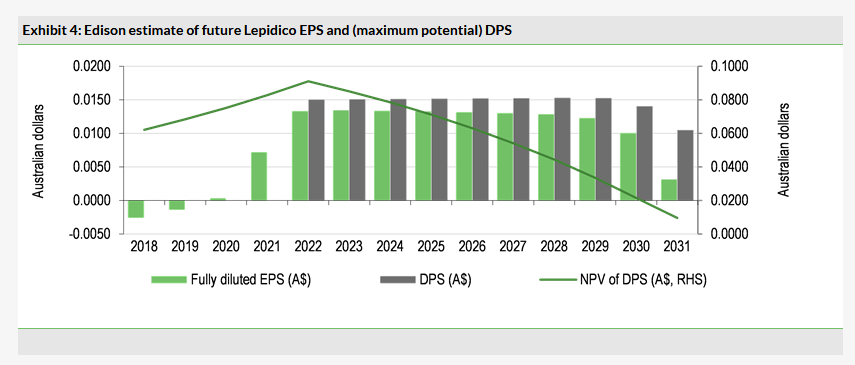
On account of the estimated US$10m reduction in capex associated with the 5,000tpa operation however, this scenario is now extremely conservative in terms of implied future financial gearing/leverage (assuming the same US$30m equity funding contingency). Whereas previously we had calculated a maximum requirement for the company of A$16.8m in debt/strategic partner-sourced funding requirements, in the aftermath of the LOH-Max changes, this reduces to just A$5.2m. Should Lepidico instead choose to maintain the same level of maximum net debt, then we calculate that it will require only US$21.2m in equity funding in H219 via the issue of an additional 1.0bn shares at the prevailing share price, in which case our immediate valuation of the company in FY19 increases to A$0.0727/share (vs A$0.0677) on account of the lower subsequent equity dilution of the project’s value.
